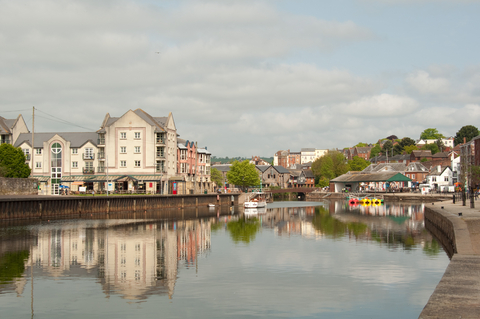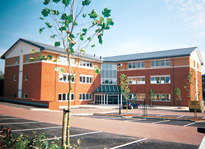
[Last updated March 2023] A guide to serviced offices and office space to rent in Exeter as well as general information that may be useful if you are thinking of renting office space in the city.
For further offices information or to search office space for rent in Exeter just click. Or contact us for any other query.
History & Geography
Set in the beautiful county of Devon, the city of Exeter is in the southwest of the country on the banks of the River Exe. Exeter lies close to the point where the Exe is joined by the River Creedy on a large floodplain and estuary. The highly fertile land nearby as well as its location near a river made Exeter a natural location for a settlement and the area was occupied by the Celts before the Romans founded the city in 50 CE as the most southwesterly fortified settlement in Roman Britain. Under the Romans, the city became a prosperous trading centre and an important strategic location. After the Romans left Britain Exeter fell into decline and its population shrank. In the 7th century, the Saxons invaded the area and took Exeter, with many settling in the city alongside the native Britons. Exeter grew again during the ninth and tenth centuries, despite sporadic attacks from the Danes. These attacks resulted in new fortifications being built around the city by King Athelstan in 928 CE. After the Norman invasion of England, William the Conqueror built Rougemont Castle in Exeter to ensure the town’s inhabitants remained loyal. The city continued to grow and prosper, fuelled by its shipbuilding and wool industries. Devon wool at that point was sold around Europe and the world for enormous profits. With the arrival of the Industrial Revolution, however, Exeter declined in importance as it was not near any sources of coal or iron. In the mid-19th century, Exeter built its railway station to connect to the Bristol and Exeter Railway and installed gas lamps and paved roads. During WWII the city was badly bombed by the Luftwaffe in retaliation for RAF raids on Lubeck in northern Germany. Much of the city centre was destroyed and many of Exeter’s historic buildings were badly damaged, including its cathedral. The city was rebuilt in the 1950s however and since has developed into one of the most important and busy British cities on the south coast.
Economy
Recently Exeter was voted one of the top ten most profitable cities in the UK for a business to be based. The three largest employers in the are the Met Office, which moved to the city in 2004, the University of Exeter, and Devon County Council. Most of the industries in the city are service-based, with its traditional industries of wool and shipbuilding having become nonexistent in the later 20th century. Indeed the entire county of Devon has for a long time been one of the poorest on the south coast due to this decline in industry. Furthermore, the foot and mouth outbreak in 2001 decimated the local agriculture industry. However, the attractive landscapes and way of life are gradually starting to attract more businesses where geographical location is not as important. The nearby town of Dartmoor, for example, has recently attracted numerous financial service companies. Also due to its scenic setting, Exeter has a thriving tourist industry.
Tourism
With the arrival of the railways in the 19th century, cities and towns in Devon became popular tourist destinations. Exeter was no exception and the town still has a strong tourism industry. However while tourism is an important bulwark of the Exeter economy, it is not as dominant as in certain other cities in the area and employs approximately seven per cent of the workforce. Most visitors come to Exeter for its beautiful setting and warm weather during the summer. The local coastline and surrounding moors are popular with hikers and campers and the city’s sedate seaside lifestyle appeals to less active visitors. Though many of the city’s famous historical buildings were destroyed in WWII there remains some of interest around the city, including Exeter Cathedral, which dates from the 11th century, and the ruins of Rougemont Castle, dating from the same period. The Northernhay Gardens, located just outside the castle, is also a popular destination for visitors and is the oldest public space in England, created in 1612. Due to it being a university town, Exeter also has an energetic nightlife which is mostly set around the centre of the city and Exeter Quay.
Transportation
Exeter has excellent transportation links to the rest of the country and Europe. The city is served by Exeter International Airport, which lies to the east of Exeter and provides flights to British and Irish regional destinations as well as flights to the European mainland. Exeter has two railway stations, Exeter St Davids and Exeter Central. The stations provide two main routes through to the capital, the fast connection to London Paddington and the slower one to London Waterloo. The city of Exeter itself is served by an extensive bus network with the main operator being Stagecoach Southwest. The city’s main bus station is on Paris Street.
 Office space to rent in Exeter
Office space to rent in Exeter
Immediately following the Great Recession, Grade A office space was fairly limited in Exeter itself, mainly due to a lack of speculative projects around 2008 during the financial crisis.
However, demand was low at that time, which led to a static rental price and an increase in incentives.
In 2013, a fairly large amount of office space was in development in the area, including projects such as Skypark and Exeter Science Park which are both located outside the city to the east.
In 2013, rents in the city were £18 per square foot in the centre of town, and £16.50 for out-of-town space.
In 2022, office space take-up was circa 150,000 square feet and this was boosted by Jurassic Fibre’s acquisition of 21,824 square feet at Milford House, and the letting of 13,096 square feet at Belvedere House to Coaching Focus.
In 2023, prime headline office rent is now £23.50 per square foot and is being quoted at Broadwalk House and Longbrook House.
Exeter office agents believe that due to low supply and few speculative developments in the pipeline, rents will reach £26 per sqft in 2024.
The majority of office deals were sub-5,000 square feet and it was observed that a large number of occupiers in the sub-2000 square feet category were opting for flexible office space and workspace solutions offered by serviced office providers.
There are 11 flex space providers in Exeter offering solutions such as private serviced offices on short-term contracts and all-inclusive pricing, managed office suites and corporate coworking desk space membership plans.
Profiles of all providers can be seen in this directory.
Our office space search, advisory and acquisition services are FREE, always. Our Exeter office space brokers and agents are globally regulated by the Royal Institution of Chartered Surveyors (RICS) ensuring the highest standards of commercial property advice and service at all times.

The Office Providers is Regulated by the RICS